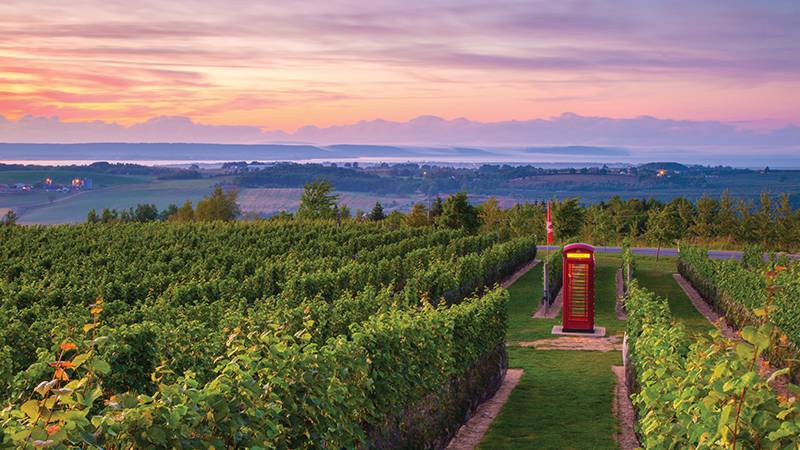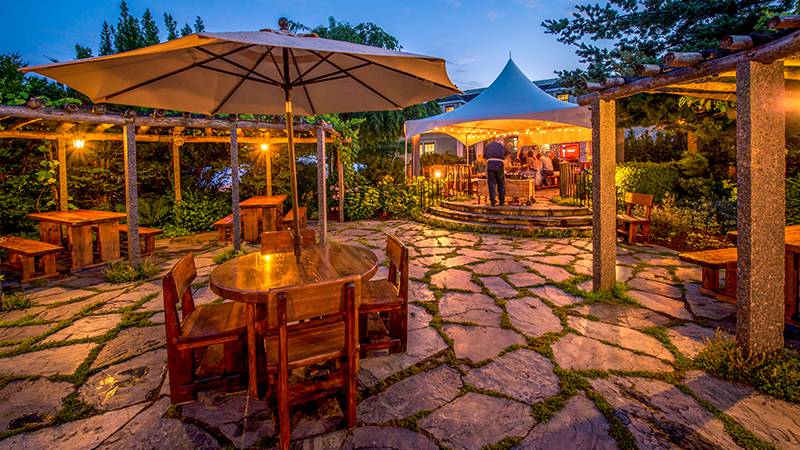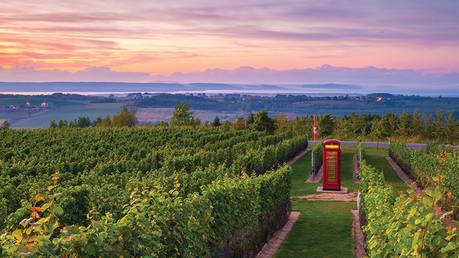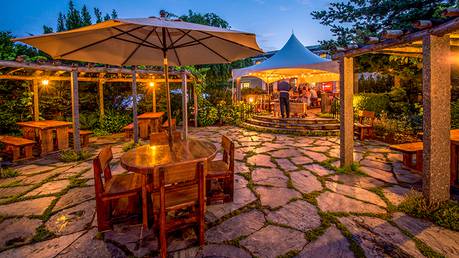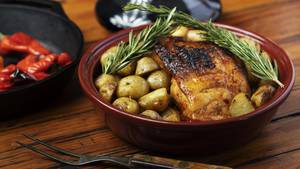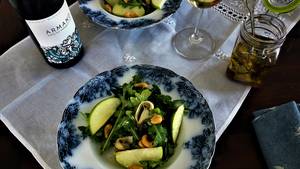Coming Home
By Mark DeWolf, CAPS National President
Jost Vineyards — Nova Scotia’s largest winery — welcomes tens of thousands of visitors to its winery in Malagash on the province’s scenic Sunrise Trail, a stone’s throw from the Northumberland Strait, but the heart of the action is in the Annapolis Valley.
Wolfville, my ancestral hometown, is the hub of valley tourism. It’s Main Street, a veritable Rockwellian image complete with red brick fire station, country stores, cafés, bistros and even comes with an expansive — perfect for a summer picnic — lawn in front of Wolfville’s Acadia University. There’s a definitive rural charm to the town, only slightly disrupted each summer by the “come from aways,” sharing in its utopian splendour.
For me, a visit to wine country begins by making a sweeping turn at Exit 10 off Highway 101. The road through Grand Pré — the world heritage site commemorating the expulsion of the French Acadians from Nova Scotia — is a true display of the local food and drink culture that has been fermenting in Nova Scotia for decades. Just Us! Coffee, Canada’s first fair trade coffee roaster, is the ideal place for a pre-wine tour espresso. Walking distance down the road, Tangled Garden, feels like a cross of hippie retreat and contemporary art exposition, as its wild gardens, the source of the herbs and botanicals used to make its fragrant jellies and liqueurs, seem both wild and free and like a well conceptualized work of art at the same time. The store and tea room, not surprisingly, are a showcase of its owner’s organic sculptures. My first purchase of the day is always some Tangled Garden lavender jelly.
Next stop is Domaine de Grand Pré — now considered “old school” producers by locals. The Stutz family, led by patriarch Hanspeter Stutz, transformed the property that once housed Nova Scotia’s first winery in the mid- to late-1990s. For the better part of the last two decades, its Le Caveau Restaurant overlooking the estate vines has been my favourite place in wine country. Surrounded by greenery, it’s an elegant yet comforting place for a light lunch and an opportunity to breathe in the freshness of a glass of their Tidal Bay — which, made under the direction of Hanspeter’s son Jurg, I consider to be one of the archetypical definitions of Nova Scotia’s signature wine style, as it is invariably bright, fresh, delicately aromatic and always food friendly. Some local cheeses, Chef Jason Lynch’s smoked duck breast and a jar of his much in-demand bacon jam, found at the onsite tasting room, usually find a way into my bag for a post-tour snack.
By this point of the day, I am usually content, but knowing Lightfoot & Wolfville (L & W) is only a few minutes away, it isn’t hard to pick oneself up to move on. Last year’s opening of L & W, was a seminal moment for the local industry. In the early 1980s Jost and the original Grand Pré were the early pioneers. In the 1990s, Domaine de Grand Pré forced the industry to raise the bar higher. Then in the 2000s Benjamin Bridge did so and more with its world-class sparklers. Now L & W brings it all together with both great liquid in the bottle and a world-class tourism experience which this summer will include a patio menu full of local seafood, charcuterie and wood-fired pizzas. Save me a table so I can delight in the beauty of the Minas Basin and sip on their Chablis-like chardonnay. The winery’s vinous offerings are rooted in terroir driven styles, embellished by owners Mike and Jocelyn Lightfoot’s commitment to organic and biodynamic practices. They have classics in the form of traditional method sparklers, Tidal Bay, pinot noir and chardonnay, but be sure to try one of their more idiosyncratic offerings. You never know what you might find. It could be a nervy riesling, a fragrant scheurebe or even a fruity kékfrankos. For a young industry, it is all about finding the right ecological fit, and the Lightfoots are willingly doing the exploration for the industry.
From L & W it’s a few minutes to Wolfville, where you can rest your head at the charming Blomidon Inn, housed in a restored Victorian mansion. For something a little more elegant, try the nearby Tattingstone Inn. Its main rooms are well-appointed, but for a more romantic and secluded adventure, book Toad Hall, a two-storey private cottage behind the main house that comes complete with its own private entrance and Jacuzzi tub. The next day, no matter the direction you’ll discover more of Nova Scotia wine country. The Gaspereau Valley, a sub-region of the larger Annapolis Valley, is only a three-minute drive away. Here you’ll find sparkling producers including L’Acadie Vineyards and Benjamin Bridge, who have pushed the traditional method sparkling wine agenda to the fore with their uncompromising commitment to edgy, mineral-tinged, electrifying styles that make us salivate in anticipation of more. Nearby you’ll find the quaint charms of Gaspereau Vineyards and a trip to the region isn’t complete without a hike up the hill to Luckett Vineyards, where you can call home from their English-style red phone-box set amidst the vines. Be sure to tell the world about your Nova Scotia wine county adventure.
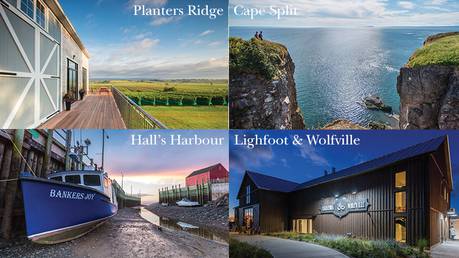
Somm Tips
1. Planters Ridge
2. Cape Split
3. Lightfoot & Wolfville
4. Hall’s Harbour
1. Lesley Quinn, The Port by the NSLC, Halifax
2017 Best Sommelier of Atlantic Canada
My ideal day in the Valley would start with a tasting and tour of the chic and stunning new Lightfoot & Wolfville winery, followed by some Tidal Bore rafting. Then a late lunch at The Port Pub to soak in the awesome views from their killer deck and finish it off with some wine and yoga at Planters Ridge winery.
2. Simon Rafuse, CAPS Atlantic Instructor, Winemaker, Blomidon Estate, Canning
If you want a unique dining experience, a picnic at Cape Split is a must. The local farmers’ markets, such as Hennigar’s, Noggins and certainly the Wolfville Farmers’ Market, have everything you need for nibbles and you can pick up a cold bottle of bubbly on your way. Just make sure you bring plenty of food, because you’ll work up an appetite on the hike in.
3. Erin Beazley, Sommelier, Obladee Wine Bar, Halifax
Start your weekend with a relaxed and delicious brunch with the fine folks at the Blomidon Inn. Peruse their wine list for some unique gems then hop on the Magic Winery Bus tour! Be sure to pick up a bottle of sparkling from Bruce at L’Acadie Vineyards (the original sparkling king) and view the organic and biodynamic turf at Lightfoot & Wolfville. After your rounds hop off at the Library Pub for a local pint or glass of Nova Scotia Tidal Bay. I’ll meet you there!
4. Rayell Swan, Sommelier, The Port by the NSLC, Halifax
A visit to the postcard worthy and quaint fishing community of Hall’s Harbour is one of my top Annapolis Valley experiences. Located approximately 30 minutes from Wolfville, it is a short, pleasant drive to the coast. The picturesque backdrop of docked fishing boats is accentuated by the wonder of the dramatic Bay of Fundy tides. Be sure to visit the Hall’s Harbour Lobster Pound for quality, fresh seafood dinner options. My recommendation is to opt for takeout near the shoreline, ideally paired with a signature local white wine and watch the stunning sunset for a memorable experience.
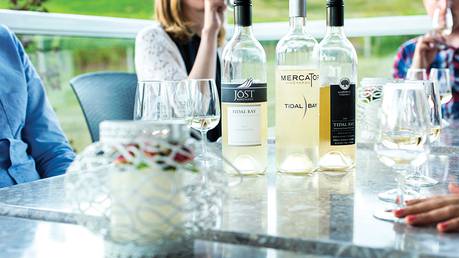
Tidal Bay
Pairs well with seafood and ocean views
The wines of Nova Scotia’s Tidal Bay appellation certainly do pair well with seafood and ocean views, but there is much more to these revolutionary wines than a simple catch phrase. The wines provide definition to a local industry seeking to carve out a name for itself in a national market. In an effort to showcase the industry’s best, local producers have formulated an appellation not dissimilar to European models as the wines must be produced with defined vineyard and winemaking practices, including maximum yields, gentle pressing, restrictions on additions of acid and sugar. The wines must additionally pass the Independent Tasting Panel analysis, largely made up of CAPS members in charge of ensuring the wines express the signature fresh, crisp, subtly aromatic qualities that define Nova Scotia’s terroir.
By the numbers
115 billion tons
The volume of water that flows in and out of the Bay of Fundy each day. It is the key climatic condition that regulates the climate of the vineyards in Nova Scotia’s Annapolis Valley.
100
Percentage of Nova Scotia grown grapes used to make Tidal Bay.
50
Minimum percentage of region’s primary varietals that make up singularly or in combination a Tidal Bay blend.
15
Maximum percentage of aromatic grapes, such as gewürztraminer, muscat and others permitted in the blend.
11
Number of Nova Scotia wineries releasing a 2017 Tidal Bay.
Continued reading
Photos Courtesy of Tourism Nova Scotia:
Luckett Vineyards, Domaine de Grand Pré, Planters Ridge, Cape Split, Lightfoot & Wolfville, Hall's Harbour, Tidal Bay Wines

